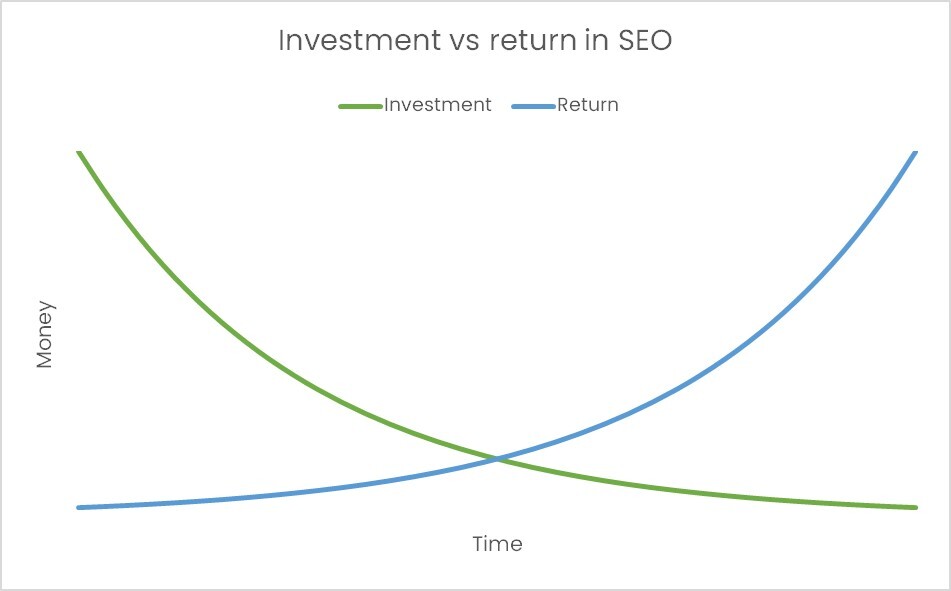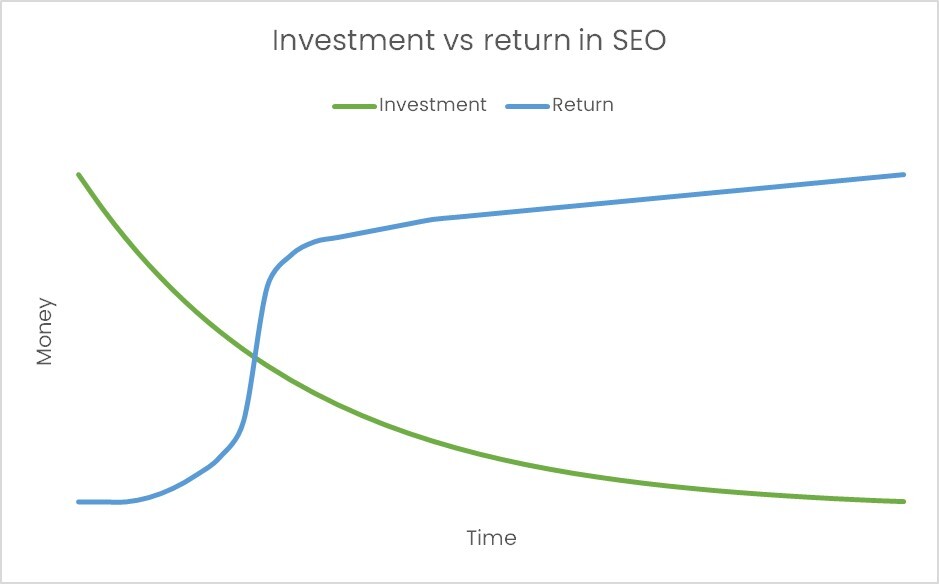Measuring ROI in SEO

By Mark Chalcraft|3 Jul 2023
SEO | 8 MIN READ
In this blog, I share knowing the signs of SEO success and what to look for and finding hidden value in other methods that you can use to report positive traction with your SEO efforts.
Rapid returns may be the result if there are a small number of issues causing major suppression. In reality, these are the exception – in most cases, sites suffer from the cumulative impact of multiple issues that naturally take longer to resolve.
Mark Chalcraft, Head of Technical SEO
In my experience, most blog posts about measuring ROI for SEO focus on explaining which metrics to use and how to access them. I'm going to assume that, as marketers, you have a decent handle on this already.
We recommend getting as close as you can to your organisation's bottom line for those that don't. For an eCommerce business, focus primarily on revenue. For lead generation, use goal conversions that track when users first enquire or request a trial.
For many organisations, the real value of each lead can vary significantly, which is challenging to incorporate into a web analytics platform. If this isn't possible, consider using relative values across the different goals you track to (at least) provide a method of comparison.
Looking at the level of traffic coming from search engines is also important, and for this, you can use your web analytics and tools like Google's Search Console to provide the search engine's reporting.
Instead, this post focuses more on what you should look for in your data, for example:
- What are the signs that your strategy is working?
- How can you set expectations within your organisation about SEO?
- What do you need to be aware of when planning your SEO strategy?
- How can you report on success in ways that provide a true picture?
In the sections below, I'll talk primarily about Google, but these principles apply to other search engines as well, principally that:
- Return on SEO effort needs to be measured over the long term, particularly with sites that have low-performance levels to begin with
- Slow, steady growth doesn't mean a strategy is less effective than one delivering rapid gains – every site, business and sector is different
- In fact, return on investment may not be about growth at all – in some scenarios, preventing or minimising losses will deliver an ROI
Keep reading to learn about:
Signs of SEO success – what to look for
Writing on Google’s Search Central blog, search advocate Daniel Waisberg demonstrated ways of analysing the causes of search traffic drops. He showed that issues with visibility in search take effect in different ways – the trend for a manual penalty is far more sudden and severe than that for algorithm updates.
The same applies when the rewards are positive, depending on what work you’ve completed and what aspect of Google’s systems this influences, for example.
- Different timescales – the same activity, such as publishing new content, will not necessarily be rewarded on the same timeline or the same trajectory
- Delayed reactions – when you make improvements or fix technical issues, at scale across your site, you may need to wait several months while Google recrawls and re-evaluates everything or runs the algorithm update that takes these changes into account
- False positives – there are times when a change goes live that an immediate positive response becomes visible. However, these improvements don’t always stick – often, Google tests the page to see how users respond
The obfuscation can make it challenging to attribute subsequent growth to specific activity accurately. With so many moving parts, including the effects of a CRO programme, UX, and development improvements, it is not always possible to measure some SEO tactics accurately with total confidence.
The lengthy timescales waiting for impact in search results can mean challenges in managing expectations among other stakeholders. Educating (and doing so early) about how SEO effort manifests is essential. Trying to do this once difficult questions start being asked is less effective.
However, there are some other things you can look for to indicate that success is on its way before you start to see that extra traffic and revenue appear:
- Impression increases – Google Search Console provides a metric on impressions that reports how often your site has appeared in its results. This overview usually starts to increase some time before traffic does. It is typically a positive early sign
- Keyword counts – again, this can indicate green shoots. If your content is beginning to appear for a broader set of keywords than before, this likely indicates good progress towards better visibility for those higher volume keywords
Both of these represent better options than a traditional SEO rank tracker. That’s not to say these aren’t still useful, but rankings are volatile whichever tool you use and can quickly provide a false impression. Use ranking data with caution and always combine it with other metrics to provide context.
Do you have an SEO challenge we can help you with?
Typical SEO - the slow march to success
In most cases, SEO success does not happen overnight. Unique factors, such as baseline performance, pre-investment and market conditions, mean the exact pace of growth can vary. However, the common refrain is that success in SEO doesn’t start to show for months and can take years in some cases to mature fully.
For SEO, this means the investment curve can often be the inverse of that for growth.

For example, consider a website that has never before had any SEO investment. The initial costs will be higher, perhaps to cover the cost of the initial audit, but the return on that early investment is likely to be realised much later. By that point, the investment may naturally have decreased.
In this sense, imagine riding a bike – the amount of energy you invest into getting underway is far higher than the energy required to maintain a good speed. The energy required decreases while the speed increases.
Often, of course, the initial burst of investment unlocks additional investment in future. For example, as your efforts begin to drive revenue growth, reinvestment in a larger SEO team is one potential step.
- That up-front investment will deliver returns lasting years – without that initial injection of momentum, there would be no acceleration in future
- Likewise, you cannot realistically attribute the later returns to the lower level of investment over the same period
- With marketing budgets based around a single financial year; for some brands, especially those starting from a low-performance baseline, return on investment in SEO may be best considered over 2-3 years
Rare successes - clearing a logjam
That doesn’t mean instant and significant growth is impossible in every case. In a self-explanatory example, if an entire website is blocked so that search engines can’t even index it, removing that obstacle could lead to very rapid growth.
Similarly, if a website has major technical issues or a high level of technical debt caused by older technology, these are likely suppressing SEO performance. Eliminating them could, in effect, clear the logjam that was holding back growth.

Rapid returns may be the result if there are a small number of issues causing significant suppression. In reality, these are the exception – in most cases, sites suffer from the cumulative impact of multiple problems that naturally take longer to resolve.
In the early days of SEO, this was far more common – markets were less saturated, historical investment over time within those markets was far lower, and Google was more susceptible to rewarding practices that didn’t warrant it. Those days are gone.
- In these cases, it can be tempting to measure the impact over the short term, when growth is highest
- However, this might exclude a longer period of steadier growth that follows, which might exceed the initial burst, so it’s good to keep this as a consideration
Managing risk – prevention is better than cure
There are occasions when SEO investment will help avoid or minimise losses. The most common example is a site rebuild or redesign. Projects like this can, if not handled carefully, present a significant risk to SEO performance.
- In cases like this, understanding the value of the investment can be trickier – but not impossible. In essence, we need to look at the Cost of Inaction (COI). Simply put, this is the difference between the outcome of an action and the outcome of ignoring that action.
- In an extreme example, let’s say that a development release to your live website inadvertently resulted in the deindexation of all content from search engines. The cost of inaction could, feasibly, be all future SEO revenue.

- In most cases, the cost of inaction could be hard to estimate because the effects could be tiny in the beginning but increase slowly over time
- Advanced methods like regression analysis can be helpful ways of understanding these scenarios in more depth, using algorithms to provide a more scientific output
Other methods you can use to identify value
The previous examples are dependent on either noticeable growth in KPIs or, in the case of cost of inaction, a specific risk that requires attention. However, it’s not always so clear-cut. In some scenarios, you may need to turn to other methods.
- Reducing other marketing spend. An organisation that’s been over-reliant on other channels might aim to lower spend in those areas. PPC is the most common example, but this could apply to any channel. Just be careful that those channels aren’t driving the brand awareness that leads to future SEO traffic!
- Performance vs market trends. In a scenario where your market or sector is shrinking, a drop in SEO performance might still be delivering a return on investment. Aligning SEO data with market data can be a way to measure this – Google Trends is a good starting point because it uses search volume data
- Share of search. Another method that doesn’t rely on pure growth is to demonstrate that you are gaining on the overall share of search vs competitors. Although the process is more complex, Google Trends is an excellent tool to measure this metric – we’ll have more on how we do this in a future blog post
Maintaining the effort
As discussed, SEO is a long-term investment. While success in SEO can take years to achieve, it can be wiped out very quickly – even within a few days. There are circumstances where reducing investment can be appropriate. For most organisations, however, some level of ongoing investment is a must.
For example:
- SEO expertise to support ongoing development on your site is highly advisable. Technical changes or alterations to your navigation, to give just two examples, can negatively impact SEO performance. As mentioned above, if you’re site is being redesigned or rebuilt, SEO expertise throughout that project is essential
- User behaviours and market conditions change over time, and your SEO may need to adapt accordingly – updating content, altering user experience and so on. There is no better (or more extreme) example of this than the onset of the COVID pandemic, which saw businesses having to tear up their carefully designed marketing strategies overnight
- Your competitors won’t be standing still. If your site is dominating the search results today, they’ll be striving to knock you off your perch (to borrow a football idiom)
All being well, your SEO strategy is paying dividends and providing the opportunity for further investment to capitalise on those gains even further!
To learn more about how we help brands measure SEO activity effectively or can help with SEO strategy or you have technical SEO challenges, contact our SEO team and set up an initial call.
